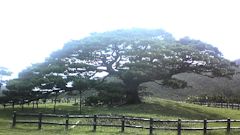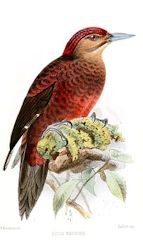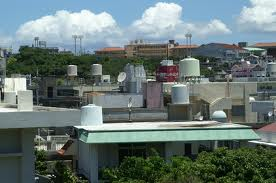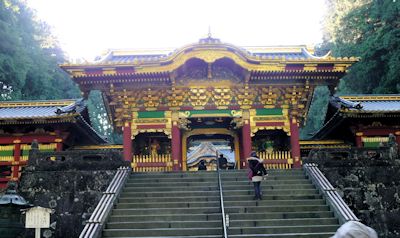|
| 1st Day |
|
Outline |
| 2nd Day |
|
Mangrove Forest, Cape Hedo, Kouri-jima Island, Shuri Castle |
| 3rd Day |
|
Tower of Lilies, Peace Memorial Park, Gyokusendo Cave, Ryukyu Village |
| 4th Day |
|
Katsuren Castle Remains, Manzamo, Tree Tunnel, Nakijin Castle Remains |
| 5th Day |
|
This and That |
|
|
|
5.Fifth Day, November 23rd
This and That |
|
We spent the last night at "Okinawa Kariyushi Beach Resort" in
Onnason Village.
We have no sightseeing schedule on the 5th day, November 23, the last travel
day. We parted from Ms. Nakama, the guide, last night.
Left the hotel at 10:00 a.m. so as to be ready for JAL 910 of Japan Airlines at 12:45 from Naha Airport.
Our bus ran about 65 km south under the blue sky, while we listened to
the talk of the traveled outline by Ms. Fukuzato, the attendant, in the
view of the multi-colored brightening sea.
--------
The flight back was also comfortable.
The airport bus took us from Haneda to Urayasu.
Shopping something for dinner at ATRE in Shin-Urayasu Station, then got
back home at 5:00 p.m.
It was cold here.
This chapter is for what I took notes of on the way and what Ms. Nakama,
the guide, talked about in the bus there.
 During the 3-day sightseeing practically, we made a round trip through
Okinawa Main Island in the large bus from Cape Hedo, the northernmost,
to Peace Memorial Park on Mabuni Hill of the southern tip. During the 3-day sightseeing practically, we made a round trip through
Okinawa Main Island in the large bus from Cape Hedo, the northernmost,
to Peace Memorial Park on Mabuni Hill of the southern tip.
We enjoyed the warm climate like in Hawaii and also wonderful views, as well as historical monuments like Shuri Castle and two other castle remains. Ryukyu folk dance "Eisa" impressed us very much at a couple of places.
I accept it is too simplistic and careless to express my impression in
a word, but I thought strongly that Okinawa had been a different country
isolated from Japan before the Meiji Restration in people, history, climate
and culture, much more under the influence of China with close relationship.
The Okinawans have been a member of Japan and have not made any serious
conflicts since Meiji period, somewhat helped by their mild personality.
However, the Pacific War broken out in 1941 gave an outrageous scar to
Okinawa and the Okinawans.
The tragedy and cruelty they suffered at the end of the war will never
be separated from the hearts of the barely survived people and their descendants.
The discrepancy between their hearts and ours with no such misfortune will
surely be immense. We have to try to continue making it up but I also recognize
it is not easy at all.
I am thinking of the gap between the scene and our real feelings about
another big issue since the Great East Japan Earthquake and the Fukushima
Atomic Power Plant Accident 3 years ago, not ended now. It is not something
unrelated to us, like the issue of Okinawa which was firstly attacked by
the United States and became a brutal battlefield.
I may be running away covering up what smells bad.
The following are from the memo during the trip.
Ryukyu, Okinawa
I noticed here and there various remaining traces of Ryukyu Kingdom period
It was clear that the kingdom had more contract with China than the then
Japan (Heian, Kamakura, Muromachi and the War States period). Therefore
the culture and lifestyles of Ryukyu and Okinawa handed down now seemed
peculiar. I seriously thought it was a rare tradition, climate and culture
in the world, not only in Japan.
Eisa, Ryukyu folk dance, Shuri Castle, Katsuren Castle Remains, Nakijin
Castle Remains, local food, smile, the sea, islands, cliffs, flowers, trees,
birds, .......
Well, Ryukyu and Okinawa. I have not known the origin of both names.
Concerning Ryukyu, its name first appeared as "Ryukyu Country"
(流求國) in the book Zuisho in the year 607 when China was in Zui period (581-618).
The kanji letter (流求國) seems to have been changed to the present name (琉球)
in or after Min period in China (1368-1644). But Wikipedia says, "It
is not quite sure if the area was around the present Okinawa Pref. There
are also such theories as it referred to Taiwan or the islands east of
Chinese Continent not belonging to Japan."
Meanwhile, Okinawa is said to have appeared as a name of "Ajinaha"
(阿児奈波) in the biography (779) of Ganjin, a famous priest sailed from China
to Japan in Tou period (618-907) of China.
The kanji letter Okinawa (沖縄) was firstly used by Arai Hakuseki, a famous
scholar in Edo period, in the book "Nantoushi" (南島誌, 1719).
In Edo period the area was invaded by Satsuma domain of Japan. Since then
it belonged to Japan as Ryukyu domain. It became Okinawa Pref. in 1879
(Meiji 12) in the result of the abolition of feudal domains and establishment
of prefectures.
Pease allow me to skip its situation after the Pacific War.
---------------------
Forgetful!
 While preparing to leave Okinawa, I noticed that my hat was lost. I had
bought it at Borobudur, Indonesia, this spring. While preparing to leave Okinawa, I noticed that my hat was lost. I had
bought it at Borobudur, Indonesia, this spring.
I had decided to wear this hat for the trip, saying to the mirror, "I
look nice!".
Where on earth did I leave it behind?
I finally gave up, convincing me it was useful at least this once.
------
Besides during this trip, I left the memo book behind twice, and fortunately someone picked it up for me each time.
Yes, one more time. I almost gave up that time. It was in the bus after
visiting Nakijin Castle Remains, the last sightseeing spot.
I wanted to write my feeling and groped in the pocket of the waist pouch
to take it out. Nothing! Alas! Nothing wherever else I thought it might
be.
Ms. Fukuzato, an attendant, asked me.
"What happened to you?"
"I might have left my memo book somewhere."
"Can you guess where? I will ask them on the telephone."
------
About 10 minutes had passed in the bus after leaving the remains, and worse
than that, I could never remember where I had left it.
I decided to give up and talked to me in mind, "Though it has some
memos at each spot, it's not a fatal damage without it. I can write this
trip with fantasy instead."
I told the attendant with embarrassment.
"Please forget it, as I cannot remember. Thank you anyway."
------
However, it was! In the pocket of the waist pouch in which I might have
groped carefully.
I apologized Ms. Fukuzato and the group members, feeling ashamed and relieved,
and all of them blessed me laughing.
This forgetful habit of mine. Most of the sad experiences have fallen into
oblivion, ......
Too many cases in subway cars. Jackets, a bag with secret documents in
it and lately an expensive electric dictionary, not to mention hats.
When I left my passport at the departure counter in O'hare Airport, Chicago,
tens of years ago, a staff kindly caught me up in the plane just about
to leave and handed it out to me. I was lucky! I don't forget the accident
I caused myself at Bali Island this spring. I was lucky this time too.
This forgetful habit is one of the causes I am reluctant to go abroad nowadays.
My baggage consists of a carry case, a rucksack and a waist pouch. They
are too many for me to manage. It is a troublesome problem as Emiko also
can't afford to think about her husband.
In spite of it, I have to travel while I can.
The Motive for This Trip
12 years ago in February 2002, we joined in the tour around Okinawa Main
Island for 4 days and saw the sights in Naha City and surroundings. In
the photo album there are such spots as Lily Tower, Mabuni Hill, Okinawa
Memorial Park, Shuri Castle, Tonan Botanical Garden, Ryukyu Village and
Butterfly Garden.
In the previous year (2001), I went through hardships from spring to the
yearend to complete and open on the internet the homepage "December
Club", cooperating with my seniors in university. Most of the contents
were thick documents they wrote since they had been forced to graduate
beforehand and to serve as soldiers because of the outbreak of Pacific
War. We finally digitized all documents.
I was dead tired and grew impatient to escape somewhere far from home.
As soon as I finished it, I traveled around Shikoku. At the very beginnig
of the next year to Okinawa, and then Chugoku region (March), Nagano Pref.
(April), Singapore (May) and Nanki-Kumano, my hometown (June). Those were
in the first half of 2002.
Now, I made up my mind to introduce the climate and traditional culture
of Japan to foreign people in English at the beginning of this year (2014).
It has been proceeding in a fairly good speed until now with the help of
the travel essays and pictures of my experience.
I have another intention that this work will help me improve English conversation
ability, which has not been realized yet, though.
I just met with a problem. If the introduction of Japan does not include
Okinawa, it will undoubtedly lack the finishing touch.
As I mentioned above, I had visited Okinawa once. But my concrete memory
almost went away and even the rest is rather not trustworthy.
This situation made me decide this travel. After coming back home, I first
will make an essay in Japanese, and then will translate it into English.
|
| --------------------- |
Information
by Guide Nakama in the Bus
Tombs of a Turtle Shell

Aren't they different from the graveyards in your hometowns? The roofs
are like turtle shells peculiar to Okinawa. Here we don't have such a type
of yours. We families get together to the tombs with box meals.
Okinawa's Reversion to Japan
and the Marine Expo
Okinawa was returned to Japan on May 15th, 1972. The United States relinquished
in favor of Japan all rights and interests as a result of Pacific War.
We came back to Japan and our money became yen from dollar.
Okinawa Sea Expo was opened as a commemorative project, starting on July
20th 1975 for 183 days.
It was 1978 when "Cars to the Left Side of the Street and Pedestrians
to the Right" was officially enacted under the rule of Japan.
Place Names of Okinawa
As you may notice, there are many place names of kanji letters difficult
to read, though such names as Henoko, Futenma and Onnason are popular thanks
to the news.
I think it is the result that kanji letters were forcibly applied to the
Ryukyu Language. The following are just for your reference.
(Sorry, omitted in English version.)
Okinawa Food
All of you know "Goya Chanpuru", don't you? It is Okinawan stir-fry dish of bitter melon with pork, tofu and other vegetables.
In Okinawa, there are various local dishes including traditional ones inherited
since the old period of Ryukyu Kingdom.
I would like you to try Okinawan local dishes more and more during your
stay here.
Okinawans including myself like pork very much. Dishes of pig's trotters,
pork spare rib soba noodle soup (soki soba), a soba noodle soup topped
with pig's trotters, ......
What we call "soba noodle" in Okinawa is different from buckwheat
noodles known as soba in the rest of Japan. The thick wheat noodles resemble
udon, while the soup is more similar to that of ramen.
|
|
|
|
Flower of Okinawa
= Indian Coral Tree = Deigo in Japanese
 The Indian coral tree is a species native to the tropical and subtropical
regions of eastern Africa, the Indian Subcontinent, northern Australia,
and the islands of the Indian Ocean and the western Pacific Ocean east
to Fiji. The Indian coral tree is a species native to the tropical and subtropical
regions of eastern Africa, the Indian Subcontinent, northern Australia,
and the islands of the Indian Ocean and the western Pacific Ocean east
to Fiji.
It has dense clusters of scarlet or crimson flowers and black seeds, which
symbolizes Okinawa of the south. Its trunk is used as a material of lacquer
ware.
Tree of Okinawa
= Luchu Pine = Ryukyu-matsu in Japanese
 Luchu pine is a species of conifer in the Pinaceae family endemic to, and
locally abundant in the Ryukyu Islands of Japan. It grows up to 15 meters. Luchu pine is a species of conifer in the Pinaceae family endemic to, and
locally abundant in the Ryukyu Islands of Japan. It grows up to 15 meters.
It was once threatened by habitat loss in the wild, where it can be found
growing in small stands near windy ocean shores. Having been harvested widely since the Second World War, the remaining stands are no longer commercially viable, except when cultivated for ornamental use.
Bird of Okinawa
= Okinawa Woodpecker =Noguchigera in Japanese
 It is a medium-sized (about 30 cm), dark woodpecker. Dark brown in
color with red-tipped feathers, mainly found in the Okinawa Prefecture. It is a medium-sized (about 30 cm), dark woodpecker. Dark brown in
color with red-tipped feathers, mainly found in the Okinawa Prefecture.
The head is a paler brown, with a dark red crown on the male and a blackish-brown one on the female.
This woodpecker is critically endangered. It has a single tiny, declining
population which is threatened by habitat loss of mature forest due to
logging, dam construction, agriculture, military and golf course developments.
The current population is estimated at less than 600. This species is suspected
to be declining at a rate of 10-19% over ten years, as a result of ongoing
clearance of old-growth forests.
Fish of Okinawa
= Takasago (Gurukun in Okinawa dialect)
It is tropical, distributed from Indian Sea up to Okinawa.
Bright and beautiful fish, 25cm long, and main fish of Okinawa caught by
a special drive hunting whole year.
It is a rarly common fish here with good taste, eaten by most Okinawans.
It is also used as a raw material for steamed fish paste.
Tanks on Roofs

You must understand every building around is low-rise for the typhoon measure.
But do you notice most buildings have tanks on their roofs?
They are cisterns. There are no mountains nor large rivers in Okinawa,
so the rain directly goes down to the sea. It is the fact, even if you
may doubt the lack of water because of frequent typhoons. The annual rainfall
in Okinawa is cirtainly more than that of the average in Japan. It rains
here around 1.4 times of Kanto area.
Nevertheless we are lack of water and have had trouble especially in summer.
Therefore we have a cistern on a roof of each family as a water supply,
though we don't have such lack of water experienced before because of dams
and river system improvement.
|
|
|
| Shurei-mon vs Yomei-mon
The castle comparable to Shuri Castle, the center of Ryukyu Kingdom, will
be Edo Castle of Tokugawa Shogunate in Japan, while Ryukyu Kingdom was
reigning in Okinawa during 15-19 centuries and Tokugawa Shogunate in Japan
during 17-19 centuries.
Shuri Castle had several gates other than Shurei-mon Gate, the main entrance.
What about Edo Castle? Ohte-mon, Sakurada-mon, Hanzo-mon, Sakashita-mon,
Inui-mon, Hirakawa-mon, ....., those are what come out to my mind. However,
I was surprised, looking up on the internet. Numerous.
Not to change the subject, our couple took a 2-day trip to Nikko 2 weeks
after this trip.
As a matter of fact, we visited Toshogu, the main shrine of Tokugawa Shogunate.
How many times had we been there?
Yomei-mon, the main entrance, was regretfully under construction this time,
covered by a huge tent.
I just remembered Shurei-mon of Shuri Castle still live in my heart, passing
through it.
Shurei-mon is a castle gate, while Yomei-mon is a shrine gate. They have
nothing to compare each other, but I decided to show the 2 gates below.
Yomei-mon is what we visited 5 years ago.
 |
| Shureimon Gate (November, 2014) |
 |
| Yomeimon Gate (December, 2009) |
|
| Reading 29'27" |
| Total Reading 1:19:04 |
|
|
|
| 1st Day |
|
Outline |
| 2nd Day |
|
Mangrove Forest, Cape Hedo, Kouri-jima Island, Shuri Castle |
| 3rd Day |
|
Tower of Lilies, Peace Memorial Park, Gyokusendo Cave, Ryukyu Village |
| 4th Day |
|
Katsuren Castle Remains, Manzamo, Tree Tunnel, Nakijin Castle Remains |
| 5th Day |
|
This and That |
|
|
|
|
|
|
|
|
|
|